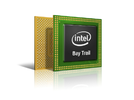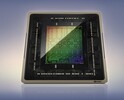NVIDIA RTX 2000 Ada Generation Laptop GPU vs Intel HD Graphics (Bay Trail) vs Nvidia RTX 5000 Ada Generation Laptop GPU
NVIDIA RTX 2000 Ada Generation Laptop GPU
► remove from comparison
The Nvidia RTX 2000 Ada Generation Laptop GPU, not to be confused with the A2000, P2000 or T2000, is a mid-range professional graphics card for use in laptops that sports 3,072 CUDA cores and 8 GB of GDDR6 VRAM. It would be fair to say that this is a GeForce RTX 4060 (Laptop) in disguise; consequently, the former is powered by the same AD107 chip as the latter, and is fast enough to handle any triple-A game at 1080p with Ultra quality settings. Brought into existence in 2023, the RTX 2000 leverages TSMC's 5 nm process and Nvidia's Ada Lovelace architecture to achieve very decent performance combined with moderate power consumption. The Nvidia-recommended TGP range for the card is very wide at 35 W to 140 W leading to bizarre performance differences between different systems powered by what is supposed to be the same product.
Quadro series graphics cards ship with much different BIOS and drivers than GeForce cards and are targeted at professional users rather than gamers. Commercial product design, large-scale calculations, simulation, data mining, 24 x 7 operation, certified drivers - if any of this sounds familiar, then a Quadro card will make you happy.
Architecture and Features
Ada Lovelace brings a range of improvements over older graphics cards utilizing the outgoing Ampere architecture. It's not just a better manufacturing process and a higher number of CUDA cores that we have here (up to 16,384 versus 10,752); under-the-hood refinements are plentiful, including an immensely larger L2 cache, an optimized ray tracing routine (a different way is employed to determine what is transparent and what isn't), and other changes. Naturally, these graphics cards can both encode and decode some of the most widely used video codecs, AVC, HEVC and AV1 included; they also support a host of Nvidia technologies, including Optimus and DLSS 3, and they can certainly be used for various AI applications.
The RTX 2000 features 24 RT cores of the 3rd generation, 96 Tensor cores of the 4th generation and 3,072 CUDA cores. Increase those numbers by 50%, and you get an RTX 3000 Ada Generation - as long as we disregard clock speed differences, of course. Unlike costlier Ada Generation professional laptop graphics cards, the RTX 2000 comes with 8 GB of non-ECC VRAM; the lack of error correction makes this card less suitable for super-important tasks and round-the-clock operation. Much like it is with the RTX 3000 Ada Generation, the VRAM is 128-bit wide and delivers a decent bandwidth of ~256 GB/s.
The RTX 2000 Ada Generation makes use of the PCI-Express 4 protocol, just like Ampere-based cards. 8K SUHD monitors are supported, however, DP 1.4a video outputs can potentially prove to be a bottleneck down the line.
Performance
Most 2024 games are playable at 1440p on High with this GPU. That being said, the average RTX 2000 Ada in our extensive database is much closer to the RTX 4050 Laptop than it is to the RTX 4060 Laptop.
Nvidia's marketing materials mention "up to 14.5 TFLOPS" of performance, a significant downgrade compared to 20 TFLOPS delivered by the RTX 3000 Ada Generation.
Your mileage may vary depending on how competent the cooling solution of your laptop is and how high the TGP power target of the RTX 2000 Ada is.
Power consumption
Nvidia no longer divides its laptop graphics cards into Max-Q and non-max-Q models. Instead, laptop makers are free to set the TGP according to their needs, and the range can sometimes be shockingly wide. This is especially the case for the RTX 2000, as the lowest value recommended for it sits at just 35 W while the highest is 300% higher at 140 W. The slowest system built around an RTX 2000 Ada can easily be half as fast as the fastest one. This is the kind of delta that we've already seen on consumer-grade laptops featuring the latest GeForce RTX cards.
Last but not the least, the improved 5 nm process (TSMC 4N) the Ada graphics card is built with makes for very decent energy efficiency, as of mid 2023.
Intel HD Graphics (Bay Trail)
► remove from comparison
The Intel HD Graphics (Bay Trail) is a low-end integrated Bay Trail graphics card found in certain Atom models (Z3770), nettops (J2850) and notebook SoCs (N3510). It supports DirectX 11 and is based on the Ivy Bridge GPU. Clock rates and shader cores, however, are considerably lower.
Compared to Ivy Bridge, which offers either 6 or 16 Execution Units, the HD Graphics (Bay Trail) comes with only 4 EUs. The core clock is significantly lower as well. Depending on the specific model, the maximum Turbo Boost is 896 MHz or less and the memory controller can support DDR3(L), DDR3L-RS or LPDDR3 in single- or dual-channel operation.
The fastest notebook models equipped with this GPU nearly match the performance of the HD Graphics (Sandy Bridge) and the AMD Radeon HD 6310. Therefore, older and less demanding Windows games like World of Warcraft or Half-Life 2 can be played fluently in very low settings. Performance is not sufficient for most modern titles.
Compared to competing ARM SoCs, Bay Trail outperforms the Adreno 320 (which can be found in different Qualcomm SoCs like the Snapdragon 600) and offers a performance similar to the Tegra 4 GPU. That is enough power to run even the most demanding Android games smoothly in very high resolutions as of 2013.
The integrated video decoder supports all popular codecs such as MPEG2, H.264, VC1, VP8 and MVC and is suitable for resolutions up to 4K up to 100 Mbit/s. The user can connect up to two displays via HDMI 1.4 (max. 1920 x 1080) or DisplayPort 1.2 (max. 2560 x 1600). Another new feature is the support for Wireless Display and Quick Sync, Intel's fast and power efficient H-264 hardware encoder. Some of these features are not available on all models.
Depending on the model, the power consumption of the entire SoC is somewhere between 2 and 10 W. The most efficient versions are therefore suitable for passively cooled tablets, whereas faster variants are used in larger subnotebooks with active cooling.
Nvidia RTX 5000 Ada Generation Laptop GPU
► remove from comparison
The Nvidia RTX 5000 Ada Generation, not to be confused with the A5000, P5000 and the RTX 5000 Turing Generation, is a super-powerful professional graphics card for use in laptops that sports 9,728 CUDA cores and 16 GB of ECC GDDR6 VRAM. Brought into existence in 2023, this graphics adapter leverages TSMC's 5 nm process and Nvidia's Ada Lovelace architecture to achieve great performance combined with reasonable power consumption. The Nvidia-recommended TGP range for the card is very wide at 80 W to 175 W leading to bizarre performance differences between different systems powered by what is supposed to be the same product.
Hardware-wise, the RTX 5000 is a GeForce RTX 4090 Laptop in disguise. Consequently, both make use of the AD103 chip and have little difficulty running triple-A games at UHD 2160p.
Quadro series graphics cards ship with much different BIOS and drivers than GeForce cards and are targeted at professional users rather than gamers. Commercial product design, large-scale calculations, simulation, data mining, 24 x 7 operation - if any of this sounds familiar, then a Quadro card will make you happy.
Architecture and Features
Ada Lovelace brings a range of improvements over older graphics cards utilizing the outgoing Ampere architecture. It's not just a better manufacturing process and a higher number of CUDA cores that we have here (up to 16,384 versus 10,752); under-the-hood refinements are plentiful, including an immensely larger L2 cache and an optimized ray tracing routine (a different way to determine what is transparent and what isn't is used) and other changes. Naturally, these graphics cards can both encode and decode some of the most widely used video codecs, AVC, HEVC and AV1 included; they also support a host of proprietary Nvidia technologies, including Optimus and DLSS 3, and they can certainly be used for various AI tasks.
The RTX 5000 features 76 RT cores of the 3rd generation, 304 Tensor cores of the 4th generation and 9,728 CUDA cores, making it a lot faster than the RTX 4000 Ada Generation. Elsewhere, the graphics card comes with 16 GB of 256-bit wide ECC GDDR6 memory for an impressive throughput of ~576 GB/s. Error correction can be turned off if desired. The fact that error correction is present here proves that the RTX 5000 is indeed targeted at professional users.
Just like Ampere-based cards, the RTX 5000 makes use of the PCI-Express 4 protocol. 8K SUHD monitors are supported, however DP 1.4a video outputs can potentially prove to be a bottleneck down the line.
Performance
The average RTX 5000 Ada Generation in our extensive database is noticeably inferior to the GeForce RTX 4080 in some tests but is totally comparable to the GeForce RTX 4090 in other ones, such as the Geekbench 6.2 GPU Vulkan test.
Nvidia's marketing materials mention "up to 42.6 TFLOPS" of performance which is very impressive. The RTX 4000 Ada Generation delivers up to 33.5 TFLOPS, for reference, while the RTX 500 Ada is only good for 9 TFLOPS.
Your mileage may vary depending on how competent the cooling solution of your laptop is and how high the TGP power target of the RTX 5000 is. One other thing worth mentioning is that enabling error correction appears to reduce the amount of video memory that is available to applications and games by up to a gigabyte.
Power consumption
Nvidia no longer divides its laptop graphics cards into Max-Q and non-max-Q models. Instead, laptop makers are free to set the TGP according to their needs, and the range can sometimes be shockingly wide. This is the case with the RTX 5000 Ada, as the lowest value recommended for it sits at just 80 W while the highest is more than two times higher at 175 W (this most likely includes Dynamic Boost). The slowest system built around an RTX 5000 Ada can easily be 60% slower than the fastest one. This is the kind of delta that we've already seen on consumer-grade laptops featuring the latest GeForce RTX cards.
Last but not the least, the improved 5 nm process (TSMC 4N) the RTX 5000 is built with makes for very decent energy efficiency, as of mid 2023.
| NVIDIA RTX 2000 Ada Generation Laptop GPU | Intel HD Graphics (Bay Trail) | Nvidia RTX 5000 Ada Generation Laptop GPU | ||||||||||||||||||||||||||||||||||||||||||||||||||||||||||||||||||||||||||||||||||||||||||||||||||||||||||||||||
| RTX Ada Generation Laptop GPU Series |
|
|
| |||||||||||||||||||||||||||||||||||||||||||||||||||||||||||||||||||||||||||||||||||||||||||||||||||||||||||||||
| Architecture | Ada Lovelace | Gen. 7 Ivy Bridge | Ada Lovelace | |||||||||||||||||||||||||||||||||||||||||||||||||||||||||||||||||||||||||||||||||||||||||||||||||||||||||||||||
| Pipelines | 3072 - unified | 4 - unified | 9728 - unified | |||||||||||||||||||||||||||||||||||||||||||||||||||||||||||||||||||||||||||||||||||||||||||||||||||||||||||||||
| TMUs | 96 | 304 | ||||||||||||||||||||||||||||||||||||||||||||||||||||||||||||||||||||||||||||||||||||||||||||||||||||||||||||||||
| ROPs | 32 | 112 | ||||||||||||||||||||||||||||||||||||||||||||||||||||||||||||||||||||||||||||||||||||||||||||||||||||||||||||||||
| Raytracing Cores | 24 | 76 | ||||||||||||||||||||||||||||||||||||||||||||||||||||||||||||||||||||||||||||||||||||||||||||||||||||||||||||||||
| Tensor / AI Cores | 96 | 304 | ||||||||||||||||||||||||||||||||||||||||||||||||||||||||||||||||||||||||||||||||||||||||||||||||||||||||||||||||
| Cache | L2: 32 MB | L2: 64 MB | ||||||||||||||||||||||||||||||||||||||||||||||||||||||||||||||||||||||||||||||||||||||||||||||||||||||||||||||||
| Memory Speed | 16000 effective = 2000 MHz | 20000 effective = 2250 MHz | ||||||||||||||||||||||||||||||||||||||||||||||||||||||||||||||||||||||||||||||||||||||||||||||||||||||||||||||||
| Memory Bus Width | 128 Bit | 32/64/128 Bit | 256 Bit | |||||||||||||||||||||||||||||||||||||||||||||||||||||||||||||||||||||||||||||||||||||||||||||||||||||||||||||||
| Memory Type | GDDR6 | GDDR6 | ||||||||||||||||||||||||||||||||||||||||||||||||||||||||||||||||||||||||||||||||||||||||||||||||||||||||||||||||
| Max. Amount of Memory | 8 GB | 16 GB | ||||||||||||||||||||||||||||||||||||||||||||||||||||||||||||||||||||||||||||||||||||||||||||||||||||||||||||||||
| Shared Memory | no | yes | no | |||||||||||||||||||||||||||||||||||||||||||||||||||||||||||||||||||||||||||||||||||||||||||||||||||||||||||||||
| Memory Bandwidth | 256 GB/s | 576 GB/s | ||||||||||||||||||||||||||||||||||||||||||||||||||||||||||||||||||||||||||||||||||||||||||||||||||||||||||||||||
| API | DirectX 12 Ultimate, Shader 6.7, OpenGL 4.6, OpenCL 3.0, Vulkan 1.3 | DirectX 11, Shader 5.0, OpenGL 4.0, ES 3.0 | DirectX 12 Ultimate, Shader 6.7, OpenGL 4.6, OpenCL 3.0, Vulkan 1.3 | |||||||||||||||||||||||||||||||||||||||||||||||||||||||||||||||||||||||||||||||||||||||||||||||||||||||||||||||
| Power Consumption | 115 Watt (35 - 115 Watt TGP) | 150 Watt (80 - 150 Watt TGP) | ||||||||||||||||||||||||||||||||||||||||||||||||||||||||||||||||||||||||||||||||||||||||||||||||||||||||||||||||
| technology | 5 nm | 22 nm | 4 nm | |||||||||||||||||||||||||||||||||||||||||||||||||||||||||||||||||||||||||||||||||||||||||||||||||||||||||||||||
| PCIe | 4 | 4 x16/x8 | ||||||||||||||||||||||||||||||||||||||||||||||||||||||||||||||||||||||||||||||||||||||||||||||||||||||||||||||||
| Displays | 4 Displays (max.), HDMI 2.1, DisplayPort 1.4a | 4 Displays (max.), HDMI 2.1, DisplayPort 1.4a | ||||||||||||||||||||||||||||||||||||||||||||||||||||||||||||||||||||||||||||||||||||||||||||||||||||||||||||||||
| Notebook Size | large | large | ||||||||||||||||||||||||||||||||||||||||||||||||||||||||||||||||||||||||||||||||||||||||||||||||||||||||||||||||
| Date of Announcement | 21.03.2023 | 11.09.2013 | 21.03.2023 | |||||||||||||||||||||||||||||||||||||||||||||||||||||||||||||||||||||||||||||||||||||||||||||||||||||||||||||||
| Link to Manufacturer Page | images.nvidia.com | images.nvidia.com | ||||||||||||||||||||||||||||||||||||||||||||||||||||||||||||||||||||||||||||||||||||||||||||||||||||||||||||||||
| Predecessor | RTX A2000 Laptop GPU | RTX A5500 Laptop GPU | ||||||||||||||||||||||||||||||||||||||||||||||||||||||||||||||||||||||||||||||||||||||||||||||||||||||||||||||||
| Codename | Bay Trail | |||||||||||||||||||||||||||||||||||||||||||||||||||||||||||||||||||||||||||||||||||||||||||||||||||||||||||||||||
| Core Speed | 311 - 896 (Boost) MHz | 930 - 1680 (Boost) MHz | ||||||||||||||||||||||||||||||||||||||||||||||||||||||||||||||||||||||||||||||||||||||||||||||||||||||||||||||||
| Transistors | 76.3 Billion |
| ||||||||||||||||||||||||||
Benchmarks
3DM Vant. Perf. total + NVIDIA RTX 2000 Ada Generation Laptop GPU
specvp12 sw-03 + NVIDIA RTX 2000 Ada Generation Laptop GPU
Cinebench R15 OpenGL 64 Bit + NVIDIA RTX 2000 Ada Generation Laptop GPU
GFXBench T-Rex HD Offscreen C24Z16 + NVIDIA RTX 2000 Ada Generation Laptop GPU
Average Benchmarks NVIDIA RTX 2000 Ada Generation Laptop GPU → 100% n=6
Average Benchmarks Intel HD Graphics (Bay Trail) → 17% n=6
Average Benchmarks Nvidia RTX 5000 Ada Generation Laptop GPU → 140% n=6
* Smaller numbers mean a higher performance
1 This benchmark is not used for the average calculation
Game Benchmarks
The following benchmarks stem from our benchmarks of review laptops. The performance depends on the used graphics memory, clock rate, processor, system settings, drivers, and operating systems. So the results don't have to be representative for all laptops with this GPU. For detailed information on the benchmark results, click on the fps number.

Baldur's Gate 3
2023
F1 23
2023
Returnal
2023
Hogwarts Legacy
2023
F1 22
2022
Cyberpunk 2077 1.6
2022
Far Cry 6
2021
F1 2021
2021
Far Cry 5
2018
X-Plane 11.11
2018
Team Fortress 2
2017
Rocket League
2017
World of Warships
2015
Metal Gear Solid V
2015
Dota 2 Reborn
2015
The Witcher 3
2015
Dirt Rally
2015
GTA V
2015
Battlefield Hardline
2015
Evolve
2015
The Crew
2014
Far Cry 4
2014
F1 2014
2014
The Evil Within
2014
Ryse: Son of Rome
2014
Alien: Isolation
2014
Fifa 15
2014
Sims 4
2014
Risen 3: Titan Lords
2014
GRID: Autosport
2014
Watch Dogs
2014
Thief
2014
X-Plane 10.25
2013
Battlefield 4
2013
Fifa 14
2013
Total War: Rome II
2013
Saints Row IV
2013
Company of Heroes 2
2013
Metro: Last Light
2013
BioShock Infinite
2013
Tomb Raider
2013
Dead Space 3
2013
Far Cry 3
2012
Hitman: Absolution
2012
Dishonored
2012
Counter-Strike: GO
2012
Sleeping Dogs
2012
Dirt Showdown
2012
Diablo III
2012
Mass Effect 3
2012
Alan Wake
2012
Anno 2070
2011
Battlefield 3
2011
Dirt 3
2011
Mafia 2
2010
StarCraft 2
2010
Metro 2033
2010Average Gaming NVIDIA RTX 2000 Ada Generation Laptop GPU → 100%
Average Gaming 30-70 fps → 100%
Average Gaming Intel HD Graphics (Bay Trail) → 7%
Average Gaming Nvidia RTX 5000 Ada Generation Laptop GPU → 157%
Average Gaming 30-70 fps → 203%
| NVIDIA RTX 2000 Ada Generation Laptop GPU | Intel HD Graphics (Bay Trail) | Nvidia RTX 5000 Ada Generation Laptop GPU | |||||||||||||||||||
|---|---|---|---|---|---|---|---|---|---|---|---|---|---|---|---|---|---|---|---|---|---|
| low | med. | high | ultra | QHD | 4K | low | med. | high | ultra | QHD | 4K | low | med. | high | ultra | QHD | 4K | ||||
| Assassin's Creed Mirage | 113 | 103 | 97 | 76 | 58 | ||||||||||||||||
| Cyberpunk 2077 2.2 Phantom Liberty | 83 | 63 | 53 | 47 | 30 | 125 | 116.6 | 94.6 | 108.5 | 63.7 | 28.8 | ||||||||||
| Baldur's Gate 3 | 87.1 | 75.7 | 67.6 | 66.1 | 45.6 | 172.3 | 155.2 | 139.2 | 134.6 | 100.5 | 53.3 | ||||||||||
| F1 23 | 202 | 192 | 145 | 47 | 30 | ||||||||||||||||
| Star Wars Jedi Survivor | 49 | 45 | 42 | 40 | 27 | ||||||||||||||||
| Hogwarts Legacy | 101 | 80 | 64 | 53 | 38 | ||||||||||||||||
| F1 22 | 189 | 172 | 129 | 48 | 31 | 236 | 229 | 210 | 87 | 60 | 31 | ||||||||||
| Tiny Tina's Wonderlands | 129 | 113 | 79 | 63 | 45 | 228 | 203 | 157 | 129 | 92 | 51 | ||||||||||
| Cyberpunk 2077 1.6 | 101 | 81 | 72 | 65 | 41 | 118 | 115 | 106 | 102 | 70 | 35 | ||||||||||
| Far Cry 6 | 157 | 121 | 104 | 87 | 63 | ||||||||||||||||
| F1 2021 | 353 | 230 | 186.6 | 99.2 | 74.9 | ||||||||||||||||
| Strange Brigade | 382 | 207 | 168 | 147 | 101 | 408 | 326 | 291 | 268 | 203 | 105 | ||||||||||
| Far Cry 5 | 155 | 117 | 109 | 102 | 70 | 149 | 137 | 131 | 127 | 119 | 71 | ||||||||||
| X-Plane 11.11 | 117 | 103 | 81 | 155 | 134 | 105 | 88 | ||||||||||||||
| Final Fantasy XV Benchmark | 180 | 104 | 75 | 56 | 197 | 170 | 136 | 108 | 64 | ||||||||||||
| Dota 2 Reborn | 167 | 151 | 142 | 134 | 24.7 | 9.7 | 5.5 | 5.4 | 186 | 168 | 164 | 150 | 143 | ||||||||
| The Witcher 3 | 383 | 257 | 159 | 80 | 65 | 445 | 370 | 271 | 144 | 102 | |||||||||||
| GTA V | 180 | 175 | 166 | 94 | 69 | 185.4 | 179.7 | 175.3 | 117.1 | 106.6 | 108 | ||||||||||
| NVIDIA RTX 2000 Ada Generation Laptop GPU | Intel HD Graphics (Bay Trail) | Nvidia RTX 5000 Ada Generation Laptop GPU | |||||||||||||||||||
| low | med. | high | ultra | QHD | 4K | low | med. | high | ultra | QHD | 4K | low | med. | high | ultra | QHD | 4K | < 30 fps < 60 fps < 120 fps ≥ 120 fps | 1 6 11 | 1 9 8 | 2 9 7 | 5 9 2 | 1 9 6 | | < 30 fps < 60 fps < 120 fps ≥ 120 fps | 1 | 1 | 1 | 1 | | | < 30 fps < 60 fps < 120 fps ≥ 120 fps | 1 11 | 2 10 | 3 9 | 4 6 | 8 1 | 1 4 6 1 |
For more games that might be playable and a list of all games and graphics cards visit our Gaming List















































